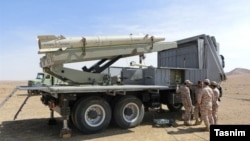The White House tells VOA it is “alarmed” by unconfirmed Western news reports that an unprecedented Iranian transfer of missiles to Russia for use against Ukraine recently happened or will occur imminently. Iran is responding to those reports by separately telling VOA that it “abstains” from arming parties engaged in the war that its ally Russia launched against Ukraine.
The Wall Street Journal reported Friday that unnamed U.S. and European officials determined in recent days that Iran has delivered ballistic missiles to Russia in what would be a first for the growing military partnership of the two anti-Western allies.
Prior to the Journal story, Bloomberg and Reuters published reports on Monday and August 10 respectively, citing unnamed European officials as saying an Iranian transfer of ballistic missiles to Russia was imminent.
VOA asked the White House National Security Council on Friday to confirm whether such a transfer already has happened or remains imminent, as the Western news outlets have reported. NSC spokesperson Sean Savett responded with a statement saying the U.S. is “alarmed by these reports.”
“Any transfer of Iranian ballistic missiles to Russia would represent a dramatic escalation in Iran’s support for Russia’s war of aggression against Ukraine,” Savett said, leaving it unclear as to whether the U.S. has detected such a transfer or not.
The Reuters report cited two European “intelligence officials” as saying the transfer would involve Iran’s Fath-360 and Ababil missiles, both of which are classified as close-range ballistic missiles with a range of less than 300 kilometers. Such Iranian missiles could free up Russia’s own missile stockpiles for longer-range strikes into Ukraine.
Savett said the United States and its partners in the Group of Seven advanced economies and the NATO alliance have “made clear ... that together we are prepared to deliver significant consequences” for an Iranian missile transfer to Russia. Western powers have supplied weapons worth billions of dollars to their ally Ukraine to push back Russia’s full-scale invasion that began in 2022.
VOA asked Iran’s U.N. Mission in New York for a response to the U.S. warning of significant consequences for any missile transfer to Russia.
In a statement received on Friday, the Iranian U.N. mission said Tehran “considers the provision of military assistance to the parties engaged in the conflict ... to be inhumane.” It added: “Not only does Iran abstain from engaging in such actions itself, but it also calls upon other countries to cease the supply of weapons to the sides involved in the conflict.”
U.S. and Europe-based researchers monitoring Iranian-Russian military cooperation told VOA there are several ways that a missile transfer could be detected by the West. They said the transfer likely would employ one of three methods: Iran shipping the missiles to Russia through the Caspian Sea, whose coastline they share, flying the missiles over the Caspian Sea or via the airspace of Azerbaijan or the airspace of Armenia and Georgia, or transporting them overland through those nations.
The researchers said open information sources such as ship and flight tracking data and satellite imagery could be used to try to detect a missile transfer being prepared or executed. But they said Iranian and Russian efforts to conceal such transfers would make detection more likely by Western intelligence agencies with access to confidential sources.
“The movement of individuals also is something that I’m looking at,” said Nicole Grajewski, a fellow at the Carnegie Endowment for International Peace.
“We saw a lot of open-source information about Russian drone operators visiting Iran to be trained in using Iranian drones,” she said. “So tracking Iranian military advisers who train Russians to use these ballistic missiles could provide another indication of a missile transfer.”
The strongest evidence of an Iranian missile transfer to Russia, Grajewski said, may come only after a transfer takes place. Remnants of Iranian missiles fired by Russia and collected by Ukrainian authorities and displayed to the world would be what she called the “smoking gun.”
The researchers interviewed by VOA said Western powers face a dilemma in considering what significant actions to take if they detect an Iranian missile transfer to Russia.
One of the most significant yet also problematic actions would be interdiction of a transfer, said Fabian Hinz, a researcher for the International Institute for Strategic Studies.
“There is no good way of interdicting these kinds of transfers, short of Western powers taking control of the Caspian Sea or the airspace above the Caspian Sea or the airspace above Russia or Iran and triggering an all-out war, which the U.S. is not going to want,” Hinz said.
Ramping up Western sanctions against Iran’s ballistic missile program and tightening export controls to further constrain Iranian access to Western components used in missile production are legal steps that the U.S. and its allies could pursue, the researchers said.
“But for a lot of these missile components, the Iranians have been adept at navigating sanctions and procuring parts,” Grajewski said.
Behnam Ben Taleblu, a senior fellow at the Foundation for Defense of Democracies, said Western powers could try to prevent or thwart a missile transfer by attempting sabotage within Iran’s missile program, or by declassifying intelligence that detects an imminent transfer and publicizing it quickly to try to deter Iran from proceeding.
“You also should make sure that wherever these Iranian missiles are going to be fired, the targeted people have the military systems to defend themselves and to offset this change in the Russian capability,” Ben Taleblu said. “For Ukraine, that means providing it with more air defenses and an independent capability to carry out long-range strikes against Russia.”
The Biden administration announced its latest U.S. military assistance package for Ukraine on Friday, saying it includes air defense missiles. U.S. officials have not authorized Ukraine to use U.S. weapons for strikes deep into Russia, citing concerns that such Ukrainian attacks could provoke Moscow into using its nuclear weapons.
VOA White House Bureau Chief Patsy Widakuswara and Pentagon correspondent Carla Babb contributed to this report.









